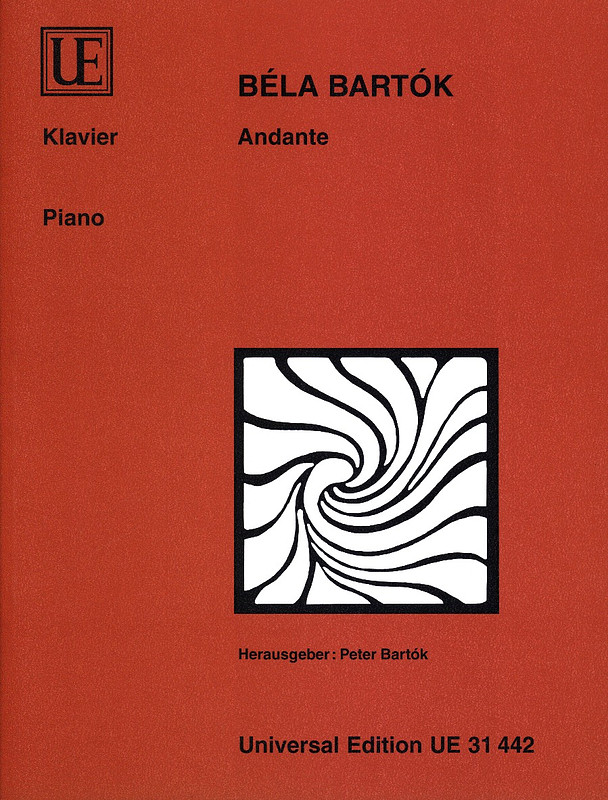
Happy Present Meet

[특가상품] Bartok Andante for Piano Solo
Two manuscripts of the "Suite", Op. 14 are held in the archive of Peter Bartók, in Florida. One of these is the autograph sketch of the work (without dynamic signs), the other is a hand written copy prepared by Márta Ziegler, Bartók's first wife, with amendments by Bartók. This latter was the engraving copy of the work; (…) The "Andante" can be found in both American manuscripts of the "Suite". What could have induced the composer to omit it from the work's final version? Before we can provide an answer, let us first examine the entire cycle (in its final form). Each of its movements - not unlike two hundred years earlier, in the baroque suites - evolves out of the basic formula of a stylized dance. In the first movement Bartók combines the throb of the baroque concertos with the rhythm of the Hungarian swineherd's dance. The following fast movement: scherzo, in the Beethovenian meaning of the word; even its tetrapodic segmentation is reminiscent of the scherzo of the "9th Symphony". The next fast movement is a characteristic Bartókian type of motion: a chase (as such, it forecasts the mood of certain scenes in the "Miraculous Mandarin"and "Cantata Profana"). After the three fast movements the scene suddenly changes: a heartbreaking slow dance movement is heard. This enormous contrast of moods is incredibly effective, particularly as it is coupled also with the finale-function: the work concludes with this slow movement. In order to preserve this effect, the composer had to forego the other slow movement. From the point of view of dramaturgy Bartók's decision was entirely correct in settling on the four movement format. The omitted "Andante", however, still deserves posterity's attention. It is a kind of minuet built on the basis of F#, with a theme consisting of major thirds (enharmonically: diminished fourths). It is woven with form units of 4, 8 and 12 bars, all of which containing 10 or 12 tones of the chromatic scale, without abandoning the tonal ground for one instant. It is an important workshop-study - and music worthy of its author. (F. Bónis)
"모음곡"의 두 원고, Op. 14개는 플로리다에 있는 Peter Bartók의 기록 보관소에 보관되어 있습니다. 그 중 하나는 작품의 사인 스케치(동적 기호 없음)이고, 다른 하나는 Bartók의 첫 부인인 Márta Ziegler가 준비하고 Bartók이 수정한 손으로 쓴 사본입니다. 후자는 작품의 판화 사본이었습니다. (…) "안단테"는 "모음곡"의 미국 원고에서 모두 찾을 수 있습니다. 작곡가가 작품의 최종 버전에서 이를 생략하도록 유도한 것은 무엇이었습니까? 답변을 제공하기 전에 먼저 전체 주기(최종 형태)를 살펴보겠습니다. 200년 전의 바로크 모음곡과 달리 각 악장은 양식화된 춤의 기본 공식에서 발전했습니다. 1악장에서 바르토크는 바로크 협주곡의 고동과 헝가리 돼지치기의 춤의 리듬을 결합합니다. 다음의 빠른 악장: 스케르초(Scherzo), 베토벤식 의미의 단어; 사지형 분할조차도 "9번 교향곡"의 스케르초를 연상시킵니다. 다음 빠른 악장은 전형적인 바르토키식 동작 유형입니다: 추격(따라서 "기적의 만다린"과 "칸타타 프로파나"에 나오는 특정 장면의 분위기를 예측합니다). 세 번의 빠른 동작이 끝난 후 장면은 갑자기 변합니다. 가슴 아픈 느린 춤 동작이 들립니다. 이 엄청난 분위기의 대조는 특히 피날레 기능과 결합되기 때문에 매우 효과적입니다. 작품은 이 느린 악장으로 마무리됩니다. 이 효과를 유지하기 위해 작곡가는 다른 느린 악장을 생략해야 했습니다. 극작법의 관점에서 볼 때 4악장 형식을 정한 바르토크의 결정은 전적으로 옳았습니다. 그러나 생략된 "안단테"는 여전히 후세의 관심을 받을 가치가 있습니다. F#을 기반으로 만들어진 일종의 미뉴에트로 장3도(합화성적으로는 감4도)로 구성된 주제를 가지고 있습니다. 4, 8, 12마디의 형태 단위로 짜여져 있으며, 모두 반음계의 10~12톤을 담고 있으며, 한 순간도 음조 기반을 버리지 않습니다. 그것은 중요한 워크숍이자 연구이며 작가에게 합당한 음악입니다. (F.보니스)
작곡가 Bartok, Bela (1881-1945)
[특가상품] Piano Lessons from Masters of the Grand Style
[특가상품] Pinto Scenas Infantis (Memories of Childhood) for 2 Pianos 4 Hands
[특가상품] Shostakovich 24 Preludes Op.34 for Piano Solo
[특가상품] Britten Scottish Ballad Op.26 for 2 Pianos 4 Hands
[특가상품] Prokofiev 4 Pieces Op.32 for Piano Solo
[특가상품] Falla Ritual Fire Dance From El Amor Brujo for Piano Solo
Szymanowski 12 Etudes Op.33 for Piano Solo
Szymanowski 9 Preludes Op.1 for Piano Solo